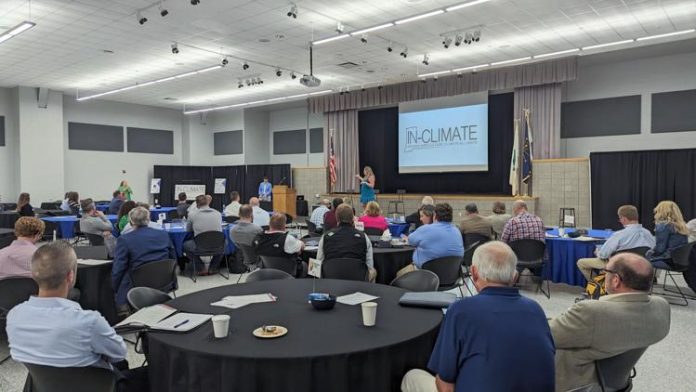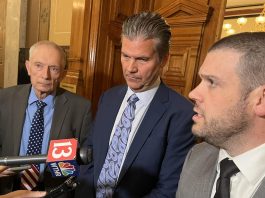Climate summit asks how Indiana agriculture can become more sustainable
By Arianna Hunt, TheStatehouseFile.com
This week, the organization IN-CLIMATE hosted its second summit showcasing different ideas to make agriculture more sustainable through conscious farming practices, new energy sources and carbon offsetting.
The annual Indiana Climate Summit bills itself as “the only gathering of professionals, producers, and government officials involved in the Midwest’s food and energy industries and climate†and aims to “educate, inform, and create a dialogue with the idea of Ag as the solution†to problems in our environment. Held in Danville, the day-long event included speakers, panel discussions and breakout sessions with attendees coming from around the U.S.
With more than 55,000 farming operations averaging 256 acres, Indiana is the eighth-largest farming state in the nation
“There’s a lot of things happening with regard to the politicization of the word ‘climate,’ and we don’t believe that’s necessary,” said Sarah Beth Aubrey, founder and CEO of IN-CLIMATE’s parent company, Elevate Ag, an agriculture consultancy located in Indiana.
Aubrey believes the politicized stigma around the word “climate” makes people afraid to engage in conversations about it. This is something that IN-CLIMATE aims to change.
“We’ve had people when we first started IN-CLIMATE, and they probably still think this, say, ‘Well, you change the name and check the climate out of the name, we might join,'” Aubrey said.
She considered their request, but she and the other founders who make up the IN-CLIMATE advisory committee decided to keep the name because the word “climate” is too important to the cause.
“One of our goals is to try to lift that [stigma around the word] so that more people are not afraid to be engaged in a dialogue that affects us all,” Aubrey said.
The event showcased many of the top ideas from different viewpoints for sustainability initiatives in agriculture.
“We don’t agree on everything, and you may not agree with everything on every panel,” said Aubrey. “I don’t think all the panelists agree with everything that they each shared today, but the fact remains that if we are advocates for ourselves in agriculture and energy and the rules of the supply chain, we’ve got to be where the top issues are coming to us.”
One of these differences in views among the speakers was over carbon credits.
Companies can earn a carbon credit for every metric ton of carbon emission they eliminate or prevent. Other businesses can buy those carbon credits to say that they have reduced or prevented one metric ton of carbon emissions.
One of these carbon credit companies is Indigo AG.
Indigo works with their grower partners to quantify their environmental impact. After they do that, they take their math to a carbon credit registry where the carbon credit is “minted,†said Brian Bartle, senior manager and partner enabler at Indigo.
Companies can buy these carbon credits as a way they can reach their sustainability goals, and the money from buying carbon credits supports farmers towards more sustainable farming practices, therefore helping the environment, said Bartle.
On the other hand, Kerwin Olson, executive director of Citizens Action Coalition in Indiana, said his organization is not thrilled with carbon credits. The problem, he said, is the credit “doesn’t really represent reducing carbon emissions.”
So carbon credits to them are like, “I’ll fly to Paris and buy a tree. You still emitted that carbon from the plane,” said Olson.
“We have no issue with incentivizing, encouraging and even enriching sectors of our economy that are improving their practices to reduce their impact. That is a very, very good thing,” said Olson. CAC is concerned that the companies buying the credits will not change their practices and instead just buy credits to say that they reduced emissions.
Another big topic of discussion at the summit was cover crops. They cover the fields and are planted after farmers harvest their cash crops.
Jimmy Emmons, a farmer from Oklahoma, shared his and other people’s testimonies over the benefits of cover crops and reduced tilling on fields.
In Emmons’ and others’ experiences, cover crops paired with little or no tilling prevented erosion, increased water intake and water retention in the soil, reduced water runoff, and elevated the soil’s ability to store carbon.
However, cover crops do not work for all farmers.
Darrel and Janet Gingerich are farmers from central Illinois. Darrel Gingerich, a president and operations manager of Gingerich Farms, says they have been consulting with an agronomist over cover crops.
While they still try cover crops, contrary to many other farmers, Gingerich Farms did not see the benefits of them, likely due to the depth of the soil. So, Gingerich has been trying what is known as strip tilling or tilling only where the crops will be planted rather than tilling the whole field as another way they can farm sustainably. The method disturbs less ground.
“We have stripped tilled, and we’re seeing a better permutation of water coming in,” he said Darrel.




